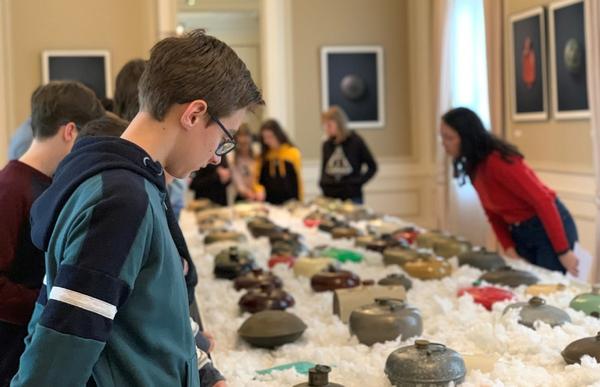Belgian Students Explore Chinese Culture

Students from the local Flemish School visit an exhibit of Chinese zodiac and warmers, known in Chinese as tangpozi, at the China Cultural Center in Brussels, Belgium, on March 1. The show ends on March 29. [Photo by Ning Yuqi/provided to chinadaily.com.cn]
Looking at an ink wash painting of the Chinese zodiac, 12-year-old Elizabeth Baxter pointed to the pig sign. "This is my Chinese zodiac," she said.
The Chinese zodiac, known as sheng xiao, is based on a 12-year cycle. It is represented by 12 animals assigned to each year. The year 2019 is a year of the pig, symbolic of a year of satisfaction in Chinese culture.
The exhibitions Chinese Zodiac and Chinese Warmers are being held at the China Cultural Center in Brussels, where about 100 zodiac-themed pieces of artwork and 100 Chinese hot-water bottles, or warmers, are on display until March 29.
It drew 20 Belgian students from Flemish School on Friday. Six Belgian schools have organized student visits to the exhibit in the past month to explore Chinese culture.
The students punctuate their visit with questions for their guide: "What do the carvings mean in China?" "Do people use warmers now in China?" "What is my zodiac?"
The exhibition features a range of artistic interpretations of the Chinese zodiac, including oil on canvas, ink wash paintings, glass artwork, ceramics, prints, decorative paper and origami.

Students from the local Flemish School visit an exhibit of Chinese zodiac and warmers, known in Chinese as tangpozi, at the China Cultural Center in Brussels, Belgium, on March 1. The show ends on March 29. [Photo by Ning Yuqi/provided to chinadaily.com.cn]
"I love everything here because they are so special, especially when the zodiac signs are put together with constellations," said Dariel Avendano. The constellations, familiar in Europe, feature in the exhibitions to resonate with European audiences.
The artworks were created by famed artist Hon Bing-wah and his wife, So Man-yee, both from Hong Kong.
"The world recognition of the couple arouses the sense of approval to cultural identity in a way," said Ge Yiyou, director of the China Cultural Center in Brussels.
Meanwhile Chinese Warmers focuses on Chinese hot-water bottles, known as tangpozi, which can be traced back to Song Dynasty (960-1279).
"The initial purpose of the exhibition is to demonstrate the warmth beneath Chinese culture. When you think of the warmers, they remind you of the warm bed, the sweet home and even your beloved motherland," Ge said.
The Belgian teens enjoyed the exhibit: "The warmers are just so cool!" said Aliyah, busy taking photos, saying "I am going to post them on my Facebook."

Students from the local Flemish School visit an exhibit of Chinese zodiac and warmers, known in Chinese as tangpozi, at the China Cultural Center in Brussels, Belgium, on March 1. The show ends on March 29. [Photo by Ning Yuqi/provided to chinadaily.com.cn]
The warmers tell the story of social change in Chinese society, from copper to enamel, from ceramics to rubber, from leather to plastic. Some of the warmers depart from the conventional round shape, with a number shaped like fish, birds and rabbits.
"I have always wanted to go to China to experience the culture," said Baxter. "The exhibitions have made me even more curious about China."
The two exhibitions try to bring Chinese culture to new audiences. "The key lies in the fusion between the cultural elements of China and Belgium," said Ge.
Located 300 meters away from the headquarters of the European Union, the cultural center held 13 major events in 2018, including Qipao exhibitions, an EU-China film festival, and concerts. It also stages Chinese film screenings and Taiji, painting, calligraphy and Chinese language classes.
"Chinese culture is never remote, it coincides with the culture of Europe," Ge said.
Ning Yuqi contributed to this story.
